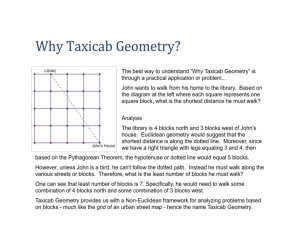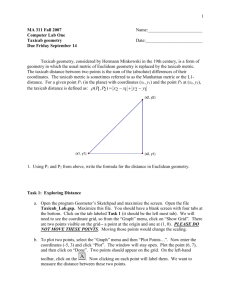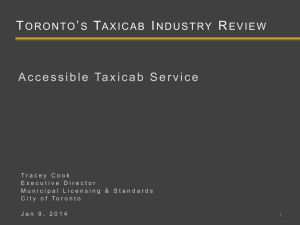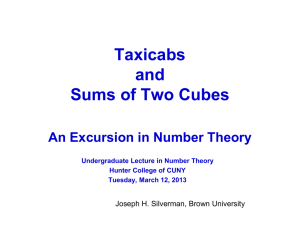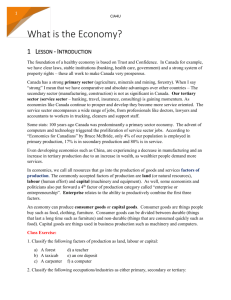New Upper Bounds for Taxicab and Cabtaxi Numbers Christian Boyer
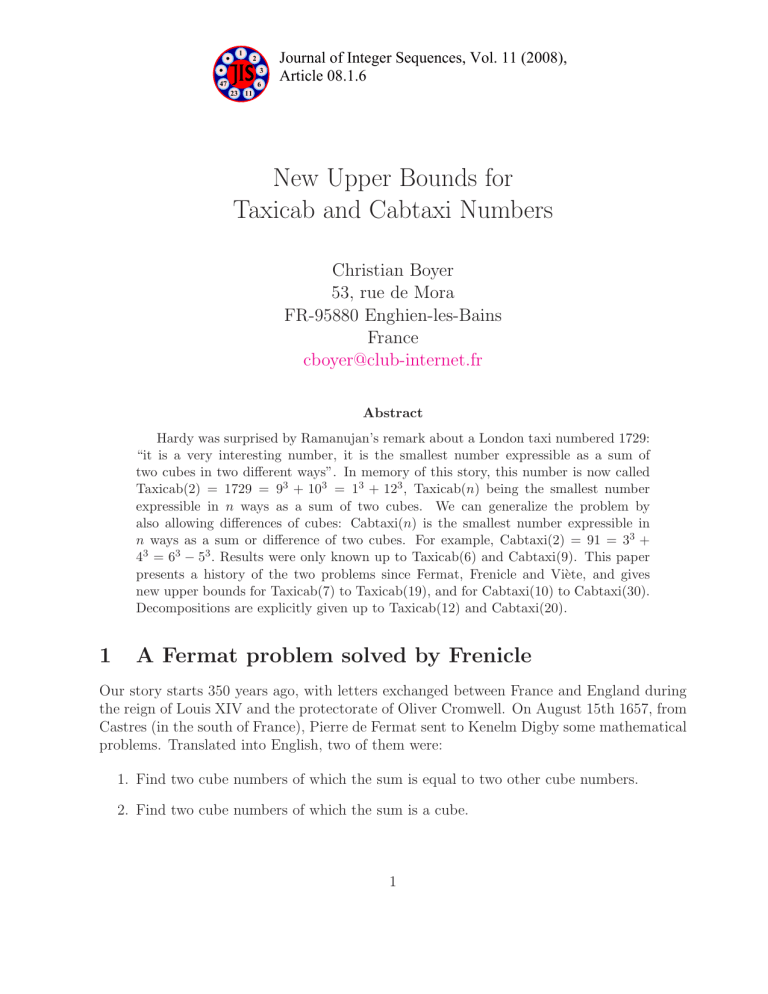
1
2
47
23 11
6
3
Journal of Integer Sequences, Vol. 11 (2008),
Article 08.1.6
New Upper Bounds for
Taxicab and Cabtaxi Numbers
Christian Boyer
53, rue de Mora
FR-95880 Enghien-les-Bains
France cboyer@club-internet.fr
Abstract
Hardy was surprised by Ramanujan’s remark about a London taxi numbered 1729:
“it is a very interesting number, it is the smallest number expressible as a sum of two cubes in two different ways”. In memory of this story, this number is now called
Taxicab(2) = 1729 = 9 3 + 10 3 = 1 3 + 12 3 , Taxicab( n ) being the smallest number expressible in n ways as a sum of two cubes. We can generalize the problem by also allowing differences of cubes: Cabtaxi( n ) is the smallest number expressible in n ways as a sum or difference of two cubes. For example, Cabtaxi(2) = 91 = 3 3
4 3 = 6 3
− 5 3
.
+
Results were only known up to Taxicab(6) and Cabtaxi(9). This paper presents a history of the two problems since Fermat, Frenicle and Vi`ete, and gives new upper bounds for Taxicab(7) to Taxicab(19), and for Cabtaxi(10) to Cabtaxi(30).
Decompositions are explicitly given up to Taxicab(12) and Cabtaxi(20).
1 A Fermat problem solved by Frenicle
Our story starts 350 years ago, with letters exchanged between France and England during the reign of Louis XIV and the protectorate of Oliver Cromwell. On August 15th 1657, from
Castres (in the south of France), Pierre de Fermat sent to Kenelm Digby some mathematical problems. Translated into English, two of them were:
1. Find two cube numbers of which the sum is equal to two other cube numbers.
2. Find two cube numbers of which the sum is a cube.
1
These two statements can be written algebraically as follows: x x
3
3
+ y
+ y
3
3
= z
= z
3
3
.
+ w
3 (1)
(2)
Fermat asked Digby, who was living in Paris at that time, to pass the problems on to William
Brouncker, John Wallis, and Bernard Frenicle de Bessy, defying them to find solutions.
Frenicle succeeded in finding several numerical solutions to ( 1 ), as announced in October
1657 in a letter sent by Brouncker to Wallis. The first solutions by Frenicle are:
1729 = 9 3 + 10 3 = 1 3 + 12 3
4104 = 9
3
+ 15
3
= 2
3
+ 16
3
. . .
Figure 1: Colbert presenting the founding members of the Acad´emie Royale des Sciences to Louis XIV, in
1666. Bernard Frenicle de Bessy (Paris circa 1605 – Paris 1675), one of the founding members, is probably
Figure 2: The two smallest of Frenicle’s solutions found in 1657, as published in Wallis’s Commercium Epistolicum, Epistola X, Oxford, 1693.
2
Brouncker added that Frenicle said nothing about equation ( 2 ). Slightly later, in February
1658, Frenicle sent numerous other solutions of ( 1 ) to Digby without any explanation of the
method used. Fermat himself worked on numbers which are sums of two cubes in more than two ways. Intelligently reusing Vi`ete’s formulae for solving x 3 = y 3 + z 3 + w 3 , he proved in his famous comments on Diophantus that it is possible to construct a number expressible as a sum of two cubes in n different ways, for any n , but his method generates huge numbers.
We know now that Fermat’s method essentially uses the addition law on an elliptic curve.
See also Theorem 412 of Hardy & Wright, using Fermat’s method [ 20 , pp. 333–334 & 339] .
It was unknown at the time whether equation ( 2 ) was soluble; we recognize Fermat’s
famous last theorem x n + y n = z n , when n = 3. This particular case was said to be impossible by Fermat in a letter sent to Digby in April 1658, and proved impossible more than one century later by Euler, in 1770. The general case for any n was also said to be impossible by Fermat in his famous note written in the margin of the Arithmetica by
Diophantus, and proved impossible by Andrew Wiles in 1993–1994. For more details on the
Fermat /Frenicle/Digby/Brouncker/Wallis letters, see [ 1 ], [ 12
We will now focus our paper on equation ( 1
). Euler worked on it [ 16 ], but the first to
have worded it exactly as the problem of the “smallest” solution, which is the true Taxicab problem, seems to have been Edward B. Escott. It was published in 1897 in L’Interm´ediaire des Math´ematiciens
Quel est le plus petit nombre entier qui soit, de deux fa¸cons diff´erentes, la somme de deux cubes? [In English: What is the smallest integer which is, in two different ways, the sum of two cubes?]
less than 100,000. C. E. Britton [ 7 ] listed all the solutions less than 5,000,000. These two
lists are given in the Appendix, figures A1a and A1b.
2 Why is 1729 called a “Taxicab” number?
37 , 44 ], in view of an anecdote, often mentioned in mathematical books, involving
the Indian mathematician Srinivasa Ramanujan (1887–1920) and the British mathematician
Godfrey Harold Hardy (1877–1947). Here is the story as related by Hardy and given, for
I remember once [probably in 1919] going to see him [Ramanujan] when he was lying ill in Putney [in the south-west of London]. I had ridden in taxicab No.
1729, and remarked that the number seemed to me rather a dull one, and that I hoped it was not an unfavourable omen. “No,” he replied, “it is a very interesting number; it is the smallest number expressible as a sum of two cubes in two different ways.”
3
As Euler did, Ramanujan worked on parametric solutions of ( 1 ). For example, even if a
similar formula had been previously found by Werebrusow [ 45
], Ramanujan found [ 2 , p. 107],
[ 29 , p. 387] the very nice condition
If m
2 + mn + n
2 = 3 a
2 b, then ( m + ab
2 ) 3 + ( bn + a ) 3 = ( bm + a ) 3 + ( n + ab
2 ) 3
.
(3)
This equation gives only a small proportion of the solutions. However, with m = 3 , n =
0 , a = 1, and b = 3, the equation yields 12 3 + 1 3 = 10 3 + 9 3 = 1729 .
Figure 3. Equations handwritten by Ramanujan in two different notebooks:
[ 29 , p. 225] (left panel), and [ 30 , p. 341] (right panel).
Euler had published the complete parametric solution in rationals of ( 1 ), but as Hardy
and Wright [ 20 , p. 200] pointed out, “The problem of finding all integral solutions is more
difficult”. In 1998, Ajai Choudhry published an interesting paper [ 11 ] on the parametric
solution in integers of ( 1 ).
3 Notation used in this paper
In this paper, Taxicab( n ) denotes the smallest integer that can be written in n ways as a sum of two cubes of positive integers. Example:
Taxicab(2) = 1729 = 12
3
+ 1
3
= 10
3
+ 9
3
.
Fermat proved that Taxicab( n ) exists for any n .
We let T ( n, k ) denote the k th smallest primitive solution that can be written in n ways as a sum of two cubes of positive integers, so that
Taxicab( n ) = T ( n, 1) (4)
Examples:
T (2 , 1) = 1729 = Taxicab(2) , T (2 , 2) = 4104 .
When Taxicab( n ) is unknown, however, we let T ′ ( n, k ) denote the k th smallest known primitive solution (at the time of the article) written in n ways as a sum of two cubes of positive integers, and T ′ ( n, 1) is an upper bound of Taxicab( n ):
Taxicab( n ) ≤ T ′ ( n, 1) (5)
4
We let Cabtaxi( n ) denote the smallest integer that can be written in n ways as a sum of two cubes of positive or negative integers. Example:
Cabtaxi(2) = 91 = 3
3
+ 4
3
= 6
3
− 5
3
.
We let C ( n, k ) denote the k th smallest primitive solution that can be written in n ways as a sum of two cubes of positive or negative integers.
Cabtaxi( n ) = C ( n, 1) (6)
When Cabtaxi( n ) is unknown, however, we let C ′ ( n, k ) denote the k th smallest known primitive solution written in n ways as a sum of two cubes of positive or negative integers.
C ′ ( n, 1) is an upper bound of Cabtaxi( n ):
Cabtaxi( n ) ≤ C ′ ( n, 1) .
(7)
4 1902–2002: from Taxicab
(3)
to Taxicab
(6)
After having asked the question above on Taxicab(2), Escott asked about Taxicab(3) in 1902
[ 15 ]. Find the smallest solution of the equation:
u
3
+ v
3
= w
3
+ x
3
= y
3
+ z
3
.
(8)
Figure 4. History of Taxicab numbers.
5
) and ( 8 ) do not help us find
the smallest solution. In 1908 Andr´e G´erardin [ 17 ] suggested that the solution was probably
175959000 = 70
3
+ 560
3
= 198
3
+ 552
3
= 315
3
+ 525
3
.
An important observation for our study and our future “splitting factors” is that G´erardin’s solution is equal to 35 3
∗ T (2 , 2). Two out of its three sums come from the second solution
4104 found by Frenicle as
70 = 2 ∗ 35 , 560 = 16 ∗ 35 ,
315 = 9 ∗ 35 , 525 = 15 ∗ 35 .
But 198 3 + 552 3 is not a multiple of 35 3 and can be considered as a “new” decomposition.
The true Taxicab(3) was discovered more than 50 years after Escott’s question, and exactly
300 years after Frenicle’s discovery of Taxicab(2). Using an EDSAC machine, John Leech
found, and published in 1957 [ 21 ], the five smallest 3-way solutions, the smallest of these five
being
Taxicab(3) = 87539319 = 167
3
+ 436
3
= 228
3
+ 423
3
= 255
3
+ 414
3
.
His results indicated that G´erardin’s solution was not Taxicab(3), but T (3 , 4) = the fourth smallest primitive 3-way solution.
E. Rosenstiel, J. A. Dardis & C. R. Rosenstiel found Taxicab(4) = 6963472309248, and
first announced it in 1989 [ 27
]. They gave more detailed results in [ 36 ], along with the next
three smallest 4-way solutions.
Until now, David W. Wilson was considered to have been the first to have discovered,
in 1997, Taxicab(5) = 48988659276962496, see [ 47
, p. 391], [ 18 , p. 212]. But, as kindly
communicated to me by Duncan Moore, this number had been previously found three years earlier in 1994 by John A. Dardis, one of the co-discoverers of Taxicab(4), and published in the February 1995 “Numbers count” column of Personal Computer World
in 1994 and Wilson in 1997, this same number was again found independently by Daniel J.
Bernstein [ 3 ] in 1998. Bill Butler also confirmed [ 8 ] this number in 2006, while computing
the fifteen 5-way solutions < 1 .
024 ∗ 10 21 .
From 1997 to 2002, the best known upper bound of Taxicab(6) was a 6-way solution
found by David W. Wilson. In July 2002, Randall L. Rathbun found [ 32 ] a better upper
bound of Taxicab(6) , 2 .
42 ∗ 10 22 , adding: “I don’t believe that this is the lowest value sum for
6 positive cube pairs of equal value”. But it seems today that it probably is the lowest value!
probability greater than 99 .
8%, but these claims are not accepted by many mathematicians.
And the computations done by Bill Butler proved that Taxicab(6) > 1 .
024 ∗ 10 21 .
5 Splitting factors
We have remarked that G´erardin’s solution was equal to 35 3
∗ T (2 , 2). It is important to note that T ′ (6 , 1) is equal to 79 3
∗ Taxicab(5), as computed by Rathbun. Among the 6
6
decompositions, only one (underlined in Fig. 4) is a “new” decomposition: the others are
79 3 multiples of the 5 decompositions of Taxicab(5).
Rathbun also remarked that other multiples of Taxicab(5) are able to produce 6-way solutions: 127 3 , 139 3 and 727 3 . I add that they are not the only multiples of Taxicab(5) producing 6-way solutions. The next one is 4622 3 , which indicates again, as for G´erardin’s solution, that non-prime numbers do not have to be skipped as we might initially assume:
79 , 127 , 139 and 727 were primes, but 4622 = 2 ∗ 2311 is not prime.
If N is an n -way sum of two cubes, and if k 3 N is an ( n + 1) -way sum of two cubes, then k is called a “splitting factor” of N .
This means that this k factor
“splits” k 3 N into a new ( n + 1)th-way sum of two cubes, the n other sums being directly the k 3 multiples of the already known n ways of N . It was called the “magnification technique” by David W. Wilson.
It is possible that other known 5-way solutions, if they have small splitting factors, may produce smaller 6-way solutions than Rathbun’s upper bound. Using the list of 5-way
solutions computed by Bill Butler [ 8 ], I have computed their splitting factors (Appendix,
figure A3). These splitting factors give the smallest known 6-way solutions < 10 26 (Appendix, figure A4): the first one remains 79 3
∗ Taxicab(5), which means that it is impossible to do best with this method. We will use this Taxicab(5) number as a basis for our search of upper bounds of Taxicab( n ), for larger n .
The method used to find all our decompositions of N into a sum of two cubes is as follows.
We first factorize N , then build a list of all its possible pair of factors ( r, s ) solving N = rs, with r < s . Because any sum of two cubes can be written as
N = rs = x
3 + y
3 = ( x + y )( x
2
− xy + y
2 ) , (9)
any possible sum of two cubes is an integer solution of the system ( 10 ) for one of the possible
pairs ( r, s ): x + y = r, x
2
− xy + y
2 = s.
(10)
We search for integer solutions of this system by solving the resulting quadratic equation.
Of course, most of the pairs ( r, s ) do not give an integer solution ( x, y ).
6 Taxicab
(7)
and beyond
The first idea is to use several of the existing splitting factors together. When we use n factors together, we add n new ways. For example, 127 3
∗ Taxicab(5) gives 5 + 1 = 6 waysolutions, and 127 3
∗ 727 3
∗ Taxicab(5) gives 5 + 2 = 7 way-solutions. Directly using this idea, the smallest 7-way solution is 79 3
∗ 127 3
∗ Taxicab(5).
The second idea is to check, once a splitting factor is used, if a completely new splitting factor is possible on the new number. In our case, yes it is! A very pleasant surprise:
79 3
∗ Taxicab(5) has a new splitting factor 101, called a “secondary” factor. And because 101 is smaller than 127, we have found a better 7-way solution 79 3
79 3
∗ 127 3
∗ Taxicab(5) .
It is possible that some other T (5 , i
∗ 101 3
∗ Taxicab(5) smaller than
) could produce a smaller 7-way
7
solution if it has a small secondary factor. This is not the case. For example, using T (5 , 6), the smallest possible 7-way solution is 25 3
∗ 367 3
∗ T (5 , 6), bigger than 79 3
∗ 101 3
∗ Taxicab(5).
Figure 5. Detailed list of splitting factors of Taxicab(5).
Figure 6. Best upper bounds, for Taxicab( n ) , n = 7 , 8 , . . . , 12 .
Figure 7. Upper bound of Taxicab(7) and its 7 decompositions
(2 more decompositions are differences of cubes)
8
The best upper bounds using this method were computed in November–December 2006, and are listed in Fig. 6. This search needed some hours on a Pentium IV. They are the current records for the upper bounds of the Taxicab numbers.
Fig. 7 gives the full decomposition of the new upper bound of Taxicab(7). Its new 7th decomposition, which is not 101 times one of the 6 decompositions of T ′ (6 , 1) from Fig. 4, is underlined.
The other decompositions of upper bounds up to Taxicab(12) are in the detailed lists of the Appendix. We may continue with the other unused splitting factors of Fig. 5, giving
(without explicitly stating their decompositions):
Taxicab(13) ≤ T ′ (13 , 1) = 4327 3
∗ T ′ (12 , 1) ≃ 5 .
99 ∗ 10 78
Taxicab(14) ≤ T ′ (14 , 1) = 4622
3
Taxicab(15) ≤ T ′ (15 , 1) = 7549
3
Taxicab(16) ≤ T ′ (16 , 1) = 8063
3
∗ T
∗ T
∗ T ′
′ (13 , 1) ≃ 5 .
91 ∗ 10
89
′ (14 , 1) ≃ 2 .
54 ∗ 10
101
(15 , 1) ≃ 1 .
33 ∗ 10
113
Taxicab(17) ≤ T ′ (17 , 1) = 14309 3
∗ T ′ (16 , 1) ≃ 3 .
91 ∗ 10 125
Taxicab(18) ≤ T ′ (18 , 1) = 16227 3
∗ T ′ (17 , 1) ≃ 1 .
67 ∗ 10 138
Taxicab(19) ≤ T ′ (19 , 1) = 23035 3
∗ T ′ (18 , 1) ≃ 2 .
04 ∗ 10 151
.
7 Cabtaxi numbers
But why should we be limited to sums of positive cubes? We can generalize the problem, allowing sums of positive or negative cubes, these are known as Cabtaxi numbers. Their story starts before that of the Taxicab numbers.
Figure 8. Fran¸cois Vi`ete (Fontenay-le-Comte 1540 – Paris 1603)
9
Figure 9. Formula “6 3 = 3 3 + 4 3 + 5 3
” by Fran¸cois Vi`ete, as republished in 1646 [ 41 , p. 75].
On 31 July 1589, the French king Henri III was killed by the monk Jacques Cl´ement and was succeeded on the throne by Henri IV. In 1591, Fran¸cois Vi`ete, “one of the most
influential men at the court” of Henri IV [ 42 , p. 3] published this very nice formula about
his problem XVIII, fourth book of Zetetica
6 3 = 3 3 + 4 3 + 5 3
.
Moving only one term, we can consider that Vi`ete knew Cabtaxi(2):
91 = 3 3 + 4 3 = 6 3
− 5 3
.
In exactly the same year, 1591, Father Pietro Bongo (“Petrus Bungus” in Latin), canon of Bergamo, independently published this same formula in Numerorum Mysteria
Bongo is also known to have “demonstrated” that the Antichrist was Martin Luther by using the Hebrew alphabet, the sum of the letters being 666: the number of the Beast. It was an answer to the German mathematician Michael Stifel (1487–1567) who previously proved, using the Latin alphabet, that Pope Leo X was the Antichrist. So strange and mystic the reasoning by some mathematicians at that time . . .
Back to mathematics! Vi`ete and Euler worked on parametric solution in rationals of: x
3 = y
3 + z
3 + w
3
.
(11)
In 1756, Euler published [ 16 ] the same
x = 6 solution of Vi`ete and Bongo, and some other
solutions. In 1920 H. W. Richmond published [ 33 ] a list of
C (2 , i ) numbers, with a solving method.
Euler was probably the first to have mentioned some 3-way solutions, his smallest being
87
3
− 79
3
= 20
3
+ 54
3
= 38
3
+ 48
3
.
But the first mention of the true Cabtaxi(3) that I have found was by Escott in 1902 [ 14 ]:
728 = 12 3
− 10 3 = 9 3
− 1 3 = 8 3 + 6 3
.
Answering Escott’s problem in 1904, Werebrusow published [ 46
formula:
If m
2 + mn + n
2 = 3 a
2 bc, then
( m + n ) c + ab
2
3
+ − ( m + n ) b − ac
2
3
= ( − mc + ab
2 ) 3 + ( mb − ac
2 ) 3
= ( − nc + ab
2 ) 3 + ( nb − ac
2 ) 3
.
(12)
10
Figure 10. History of Cabtaxi numbers.
Werebrusow needed the condition a
3 = 1, but his formula is true without this condition.
) reuses his previous 2-way formula ( 3 ). No example was given by
Werebrusow, but we can remark that Cabtaxi(3) can be found, applying ( m, n, a, b, c ) =
11
(0 , 3 , 1 , 3 , 1). Another observation is that Cabtaxi(3) can be deduced from Cabtaxi(2), using a splitting factor 2, which adds one new decomposition 9 3 of Cabtaxi(2) are 2 3 multiples of Cabtaxi(2).
− 1 3 . The two other decompositions
Cabtaxi(4), Cabtaxi(5), Cabtaxi(6), Cabtaxi(7) were found by Randall L. Rathbun in the
beginning of the 1990s [ 18 , p. 211], while Cabtaxi(8) was discovered by Daniel J. Bernstein
In the same month, January 2005, there were two nice results on Cabtaxi(9) from two
Moore’s search also proved that Cabtaxi(10) > 4 .
6 ∗ 10 17 .
Just as Taxicab(5) was a strong basis for Taxicab numbers, we observe in Fig. 10 that
Cabtaxi(6) is a strong basis used by bigger Cabtaxi numbers. These interesting relations were never published, and show the strength of splitting factors:
Cabtaxi(7) = 2 3
∗ Cabtaxi(6)
Cabtaxi(8) = 23 3
∗ Cabtaxi(7)
Cabtaxi(9) = (5 ∗ 67) 3
∗ Cabtaxi(7) .
Our method is similar to Taxicab numbers, and uses the splitting factors of Cabtaxi(9) given in Fig. 11a. However, because Jaroslaw Wroblewki’s number C ′ (9 , 2) = 8 .
25 ∗ 10 17 is close to C (9 , 1) = Cabtaxi(9) = 4 .
25 ∗ 10 17 , it is interesting also to analyze its splitting factors, as shown in Fig. 11b.
The best upper bounds up to C ′ (20 , 1) using the splitting factors of Cabtaxi(9) were computed in November–December 2006. Three better upper bounds C ′ (11 , 1) , C ′ (17 , 1) , C ′ (18 , 1) are possible, coming from C ′ (9 , 2): they were found later, in February 2007. All these numbers are listed in Fig. 12 and are the current records for the upper bounds of the Cabtaxi numbers.
Fig. 13 gives the full decomposition of the new upper bound of Cabtaxi(10). Its new
10th decomposition, which is not 13 times one of the 9 decompositions of Cabtaxi(9) from
Fig 10, is underlined.
12
Figure 11a. Detailed list of splitting factors of Cabtaxi(9) = 424910390480793000.
Figure 11b. Detailed list of splitting factors of C ′ (9 , 2) = 825001442051661504.
13
Figure 12. Best upper bounds for Cabtaxi(10) to Cabtaxi(20).
Figure 13. Upper bound of Cabtaxi(10) and its 10 decompositions.
The other decompositions of upper bounds up to Cabtaxi(20) are presented in the detailed lists of the Appendix. We may continue with the other unused splitting factors of Fig. 11a, giving (without explicitly stating their decompositions):
14
Cabtaxi(21) ≤ C ′ (21 , 1) = 349
3
∗ C ′ (20 , 1) ≃ 9 .
14 ∗ 10
76
Cabtaxi(22) ≤ C ′ (22 , 1) = 436
3
∗ C ′ (21 , 1) ≃ 7 .
57 ∗ 10
84
Cabtaxi(23) ≤ C ′ (23 , 2) = 661
3
∗ C ′ (22 , 1) ≃ 2 .
19 ∗ 10
93
Cabtaxi(24) ≤ C ′ (24 , 2) = 859 3
∗ C ′ (23 , 1) ≃ 1 .
39 ∗ 10 102
Cabtaxi(25) ≤ C ′ (25 , 2) = 1009 3
∗ C ′ (24 , 1) ≃ 1 .
42 ∗ 10 111
Cabtaxi(26) ≤ C ′ (26 , 2) = (4367 ∗ 439) 3
∗ C ′ (24 , 1) ≃ 9 .
77 ∗ 10 120
Cabtaxi(27) ≤ C ′ (27 , 2) = (4367 ∗ 439)
3
∗ C ′ (25 , 1) ≃ 1 .
00 ∗ 10
130 and of Fig 11b, giving:
Cabtaxi(21) ≤ C ′ (21 , 2) = (139 ∗ 283 ∗ 291)
3
∗ C ′ (18 , 1) ≃ 2 .
72 ∗ 10
77
Cabtaxi(22) ≤ C ′ (22 , 2) = 307
3
∗ C ′ (21 , 1) ≃ 7 .
88 ∗ 10
84
Cabtaxi(23) ≤ C ′ (23 , 1) = 379 3
∗ C ′ (22 , 1) ≃ 4 .
29 ∗ 10 92
Cabtaxi(24) ≤ C ′ (24 , 1) = 409 3
∗ C ′ (23 , 1) ≃ 2 .
94 ∗ 10 100
Cabtaxi(25) ≤ C ′ (25 , 1) = 1021 3
∗ C ′ (24 , 1) ≃ 3 .
12 ∗ 10 109
Cabtaxi(26) ≤ C ′ (26 , 1) = 1153
3
Cabtaxi(27) ≤ C ′ (27 , 1) = 1693
3
∗ C ′ (25 , 1) ≃ 4 .
79 ∗ 10
118
∗ C ′ (26 , 1) ≃ 2 .
32 ∗ 10
128
Cabtaxi(28) ≤ C ′ (28 , 1) = 1829
3
∗ C ′ (27 , 1) ≃ 1 .
42 ∗ 10
138
Cabtaxi(29) ≤ C ′ (29 , 1) = 2307
3
∗ C ′ (28 , 1) ≃ 1 .
75 ∗ 10
148
Cabtaxi(30) ≤ C ′ (30 , 1) = 5543 3
∗ C ′ (29 , 1) ≃ 2 .
97 ∗ 10 159
.
8 Unsolved problems
8.1
Are these the true Taxicab and Cabtaxi numbers?
The new upper bounds of Taxicab(7) and Cabtaxi(10) announced in this paper, and detailed in Fig 7 and 13, may have a chance of being the correct Taxicab and Cabtaxi numbers. But the probability decreases as n increases, and is close to 0 for Taxicab(19) and Cabtaxi(30).
Who can check if some of these upper bounds are the correct Taxicab and Cabtaxi numbers? Or who will find smaller upper bounds? This is a good subject for mathematical computation.
8.2
Prime versions of Taxicab and Cabtaxi numbers
Our construction with splitting factors generates sums of cubes of non-prime integers: at least n − 1 decompositions are k 3 multiples. What about sums of two cubes of primes? The
2-way solutions using only sums of cubed primes are rare. For what we can call “the prime version of Taxicab numbers”, the smallest 2-way solutions are
6058655748 = 61
3
+ 1823
3
= 1049
3
+ 1699
3
(13a)
6507811154 = 31 3 + 1867 3 = 397 3 + 1861 3
.
(13b)
15
For the prime version of Cabtaxi numbers, the smallest 2-way solutions are
62540982 = 397
105161238 = 193
3
3
− 31 3
+ 461 3
= 1867
= 709
3
3
− 1861
− 631 3
.
3 (14a)
(14b)
) is just a different arrangement of ( 13b ).
But nobody has succeeded yet (as far as we know) in constructing a 3-way solution using only sums, or sums and differences, of cubed primes. Who will be the first, or who can prove that it is impossible?
An “easier” question: instead of directly searching for a 3-way solution using 6 cubed primes, is there another 3-way solution using at least 4 cubed primes, different from this one
68913 = 40 3 + 17 3 = 41 3
− 2 3 = 89 3
− 86 3
(the 4 primes used are 17 , 41 , 2 ,
] and 386 [ 35 ] of Carlos Rivera.
A supplemental remark: our 3-way problems are unsolved, but are solved for a long time if only coprime pairs are used instead of primes. Several 3-way and 4-way solutions using sums of two coprime cubes are known. The smallest 3-way solution was found by Paul Vojta
15170835645 = 517
3
+ 2468
3
= 709
3
+ 2456
3
= 1733
3
+ 2152
3
.
And 3-way, 4-way and 5-way solutions using sums or differences of two coprime cubes are known. It is easy to find the smallest 3-way solution:
3367 = 15
3
− 2
3
= 16
3
− 9
3
= 34
3
− 33
3
.
8.3
Who can construct a 4 × 4 magic square of cubes?
A 3 × 3 magic square of cubes, using 9 distinct cubed integers, has been proved impossible
z
3 center should have x 3 + y 3 is the number in the centre cell, then any line going through the
= 2 z 3 .
Euler and Legendre demonstrated that such an equation is impossible with distinct integers.
But the question of 4 × 4 magic squares of cubes, using 16 distinct positive cubed integers,
is still open. A breakthrough was made in 2006 by Lee Morgenstern [ 5 ] who found a very
nice construction method using Taxicab numbers. If a
3
+ b
3
= c
3
+ d
3
= u and e
3 + f
3 = g
3 + h
3 = v,
(15)
(16) then the 4 × 4 square of cubes in Fig. 14 is semi-magic, its 4 rows and 4 columns having the same magic sum S = uv.
16
Figure 14. Parametric 4 × 4 magic square of cubes, Morgenstern’s method.
Using u = Taxicab(2) = 1729 and the second smallest 2-way solution v = T (2 , 2) = 4104 , both found by Frenicle, which implies ( a, b, c, d, e, f, g, h ) = (1 , 12 , 9 , 10 , 2 , 16 , 9 , 15), we find the 4 × 4 semi-magic square of cubes shown in Fig. 15.
Figure 15. 4 × 4 semi-magic square of cubes. Magic sum S = 1729 ∗ 4104 = 7 , 095 , 816 .
This is not a full solution of the problem, because this square is only “semi-magic”, in that the diagonals each have a wrong sum. The diagonals (and the square) would be fully magic if a third equation is simultaneously true:
( ae )
3
+ ( bf )
3
= ( cg )
3
+ ( dh )
3
.
(17)
Using 2-way lists kindly provided by Jaroslaw Wroblewski, University of Wroc law, I can say
that there is no solution to the system of 3 equations ( 15 ), ( 16
a, b, c, d, e, f, g, h
< 500 , 000 or with a, b, c, d < 1 , 000 , 000 and e, f, g, h < 25 , 000 .
But that does not mean that the system is impossible. The first person who finds a numerical solution of this system of 3 equations will directly get a 4 × 4 magic square of cubes! But perhaps somebody will succeed in constructing a 4 × 4 magic square of cubes using a different method. Or somebody will prove that the problem is unfortunately impossible.
9 Acknowledgements
Many thanks to Duncan Moore for his reading of drafts of this paper, his suggestions on the
text, and for alerting us to the work of Mudge [ 27 , 28 ]. And many thanks to George P. H.
Styan, who really helped me with the L TEX version of this paper. Thanks go also to Ka Lok
Chu, Jarmo Niemel¨a, and Evelyn Matheson Styan for their help.
17
References
[1] P. Beeley and C. J. Scriba, The Correspondence of John Wallis, Volume I (1641–1659) ,
Oxford University Press, 2003.
[2] B. C. Berndt, Ramanujan’s Notebooks, Part IV , Springer-Verlag, 1994.
[3] D. J. Bernstein, Enumerating solutions to p ( a ) + q ( b ) = r ( c ) + s ( d ), Mathematics of
Computation 70 (2001), 389–394; available at http://cr.yp.to/papers/sortedsums.eps
[4] C. Boyer, Some notes on the magic squares of squares problem, The Mathematical Intelligencer 27 (2005), no. 2, 52–64.
[5] C. Boyer, Site des carr´es multimagiques/Multimagic squares site/Seiten der multimagischen Quadrate. Available at http://www.multimagie.com/indexengl.htm
[6] C. Boyer, Les nombres Taxicabs, to appear in Pour La Science (2008).
[7] C. E. Britton, The equation x 3 + y 3 = u 3 + v 3 = N , Scripta Math.
25 (1960), 165–166.
[8] B. Butler, Durango Bill’s Ramanujan numbers and the Taxicab problem. Available at http://www.durangobill.com/Ramanujan.html
[9] C. S. Calude, E. Calude & M. J. Dinneen, What is the value of Taxicab(6)?, Journal of Universal Computer Science 9 (2003), 1196–1203. Available at http://www.jucs.org/jucs 9 10/what is the value
[10] C. S. Calude, E. Calude & M. J. Dinneen, What is the value of T axicab (6)? An update, CDMDTS Research Report Series, Report 261, Centre for Discrete Mathematics and Theoretical Computer Science, University of Auckland, April 2005. Available at http://www.cs.auckland.ac.nz/CDMTCS//researchreports/261cris.eps
[11] A. Choudhry, On equal sum of cubes, Rocky Mountain J. Math.
28 (1998), 1251–1257.
[12] L. E. Dickson, History of the Theory of Numbers, Volume II (Diophantine Analysis) ,
Chelsea Publishing Company, 1952.
[13] E. B. Escott, Question 1050, L’Interm´ediaire des Math´ematiciens , 4 (1897), 98–99.
[14] E. B. Escott, R´eponse 1882, Trouver quatre nombres tels que la somme de deux quelconques d’entre eux soit un cube, L’Interm´ediaire des Math´ematiciens 9 (1902), 16–17.
[15] E. B. Escott, Question 2368, L’Interm´ediaire des Math´ematiciens 9 (1902), 144.
[16] L. Euler, Solutio generalis quorundam problematum Diophanteorum quae vulgo nonnisi solutiones speciales admittere videntur, Novi commentarii academiae scientiarum
Petropolitanae 6 (1756–1757), 1761, 155–184 (reprint in Euler Opera Omnia , I-2, 428–
458).
[17] A. G´erardin, R´eponse 2368, L’Interm´ediaire des Math´ematiciens 15 (1908), 182.
18
[18] R. K. Guy, Unsolved Problems in Number Theory , Third edition, Springer-Verlag, 2004.
[19] G. H. Hardy, P. V. Seshu Aiyar & B. M. Wilson, Collected papers of Srinivasa Ramanujan , Cambridge University Press, 1927, reprint by Chelsea Publishing Company,
1962.
[20] G. H. Hardy & E. M. Wright, An Introduction to the Theory of Numbers , Fifth edition,
Oxford University Press, 1980.
[21] J. Leech, Some solutions of Diophantine equations, Proc. Cambridge Phil. Soc.
53
(1957), 778–780.
[22] J.-C. Meyrignac, The Taxicab problem. Available at http://euler.free.fr/taxicab.htm
[23] D. Moore, CabTaxi(9), NMBRTHRY Archives e-mail: February 5, 2005. Available at http://listserv.nodak.edu/cgi-bin/wa.exe?A2=ind0502&L=nmbrthry&P=55
[24] D.
Moore, Taxicab and Cabtaxi http://www.duncan.moore.freeuk.com/taxicab numbers.
Available at
[25] C. Moreau, L. Debonne, P. Tannery, P. Jolivald & H. Brocard, R´eponse 1050,
L’Interm´ediaire des Math´ematiciens 4 (1897), 286.
[26] C. Moreau, R´eponse 1050, Plus petit nombre ´egal `a la somme de deux cubes de deux fa¸cons, L’Interm´ediaire des Math´ematiciens 5 (1898), 66.
[27] M. Mudge, Numbers Count: Greedy sequences and the least integer solution of the
Diophantine equations, Personal Computer World , November 1989, 234.
[28] M. Mudge, Numbers Count: 1729 and all that, Personal Computer World , February
1995, 610.
[29] S. Ramanujan, Notebooks, Volume II , Tata Institute of Fundamental Research, Bombay,
1957 (reprint by Springer-Verlag, 1984).
[30] S. Ramanujan, The Lost Notebook and Other Unpublished Papers , Narosa Publishing
House, New Delhi, 1988.
[31] R. Rashed, C. Houzel & G. Christol, Œuvres de Pierre de Fermat, Volume I, La th´eorie des nombres , Albert Blanchard, Paris, 1999.
[32] R. L. Rathbun, Sixth Taxicab number?, NMBRTHRY Archives e-mail, July 16, 2002.
Available at http://listserv.nodak.edu/cgi-bin/wa.exe?A2=ind0207&L=NMBRTHRY&P=1278
[33] H. W. Richmond, On integers which satisfy the equation t
3
±
Cambridge Phil. Soc.
22 (1912–1923), February 1920, 389–403.
x
3
± y
3
± z
3 = 0 , Trans.
[34] C. Rivera, Puzzle 90: The prime version of the Taxicab problem. Available at http://www.primepuzzles.net/puzzles/puzz 090.htm
19
[35] C. Rivera, Puzzle 386: CabTaxi, prime version (proposed by C. Boyer). Available at http://www.primepuzzles.net/puzzles/puzz 386.htm
[36] E. Rosenstiel, J. A. Dardis & C. R. Rosenstiel, The four least solutions in distinct positive integers of the Diophantine equation s = x 3 + y 3 = z 3 + w 3 = u 3 + v 3 = m 3 + n 3 , Bull. Inst. Math. Appl.
27 (1991), 155–157. Available at http://www.cix.co.uk/˜rosenstiel/cubes/welcome.htm
[37] N.
J.
A.
Sloane, A011541 Taxicab numbers sequence, ATT Research’s Online Encyclopaedia of Integer Sequences.
Available at http://www.research.att.com/˜njas/sequences/A011541
[38] N.
J.
A.
Sloane, A047696 Cabtaxi numbers sequence, ATT Research’s Online Encyclopaedia of Integer Sequences.
Available at http://www.research.att.com/˜njas/sequences/A047696
[39] P. Tannery & C. Henry, Œuvres de Fermat, Volume 2 , Gauthier-Villars, Paris, 1894.
[40] P. Tannery & C. Henry, French translation of Wallis Commercium, in Œuvres de Fermat,
Volume 3 , Gauthier-Villars, Paris, 1896.
[41] F. Vi`ete, Zieteticorum libri quinque , first edition of 1591, or van Schooten’s edition of
1646 reprint in Vi`ete Opera Mathematica , Georg Olms Verlag, 1970.
[42] F. Vi`ete, The Analytic Art , translated by T. Richard Witmer, Kent State University
Press, 1983.
[43] J. Wallis, Commercium , reprint in Opera Mathematica, Volume II , Georg Olms Verlag,
] and [ 40 ] for a French translation).
[44] E.
Weisstein, Taxicab number, Wolfram MathWorld.
Available at http://mathworld.wolfram.com/TaxicabNumber.html
[45] A.
Werebrusow, R´eponse 2179, Tables de solutions d’´equations cubiques,
L’Interm´ediaire des Math´ematiciens 9 (1902), 164–165 & 11 (1904) 96–97 & 289.
[46] A. Werebrusow, R´eponse 1882, Equations ind´etermin´ees cubiques, L’Interm´ediaire des
Math´ematiciens 11 (1904), 288.
[47] D.
W.
Wilson, The fifth Taxicab number is 48988659276962496,
J.
Integer Sequences 2 (1999), Article http://www.cs.uwaterloo.ca/journals/JIS/wilson10.html
99.1.9.
Available at
20
10 Appendix
Figure
A1a. Smallest 2-way solutions 1
listed by Moreau.
Figure A1b. Smallest 3-way solutions listed by Leech.
Figure A2. Splitting factors of Taxicab numbers.
1 All these solutions were previously found by Frenicle.
21
Figure A3. Splitting factors of the smallest 5-way solutions.
Figure A4. Smallest 6-way solutions derived from 5-way solutions and splitting factors
(other 6-way solutions are possible, if they are not derived from 5-way solutions).
22
List 1. Upper bounds of Taxicab(7..12) and decompositions.
23
List 2. Upper bounds of Taxicab(10..20) and decompositions.
24
List 2 (cont’d). Upper bounds of Taxicab(10..20) and decompositions.
25
List 3. Upper bounds of Taxicab(13..19).
List 4. Upper bounds of Taxicab(21..30).
2000 Mathematics Subject Classification : Primary 11D25.
Keywords : Taxicab number, Cabtaxi number, Hardy–Ramanujan number, Bernard Frenicle de Bessy, Fran¸cois Vi`ete, sum of two cubes, difference of two cubes, magic square of cubes.
(Concerned with sequences A011541 , A047696 .)
Received June 26 2007; revised version received February 22 2008. Published in Journal of
Integer Sequences , March 7 2008.
Return to Journal of Integer Sequences home page .
26
